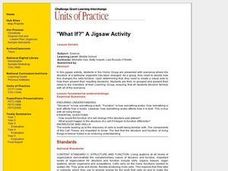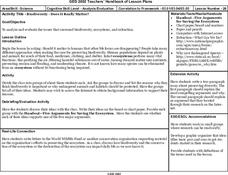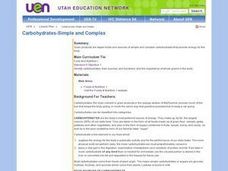Curated OER
Galapagos Adaptations
Young scholars examine photographs of closely related species found in the Gal??pagos environment, observe differences and similarities between species, and form hypotheses about species differences and the relationship to the...
Curated OER
"What If?" A Jigsaw Activity
Students, in groups, consider a scenario in which some structure of a cell has been changed. They explore how structural change affects the function of a cell and create a visual aid to illustrate their observations.
Curated OER
Learning From Leaves: A Look at Leaf Size
Students measure and analyze leaves from various environments. They discuss the environments, and make inferences about environmental variables that could have contributed to the differences in leaf size and texture.
Curated OER
Learning From Leaves: From Observation to Inference
Students examine the adaptation of plants to their environments. They analyze and observe the structure, shape, and internal structure of various leaves, and make inferences about the structures.
Curated OER
Learning From Leaves: Adaptations To Differing Light Levels
Pupils, in groups, examine plants with different light levels. They are given plants from a tropical and desert region. They write a hypothesis at the beginning of the experiment.
Curated OER
Everything in Its Place: Science Classification
Students investigate the system of classification for living things through the sixteen lessons of this unit. The five kingdoms of monerans, protists, fungi, plants, and animals form the basis of several experiments as the similarities...
Curated OER
Biodiversity - Does It Really Matter?
Students examine biodiversity, ecosystems, and extinction. They are divided into groups to discuss why they think biodiversity is important.
Curated OER
Building a Pyramid
Fifth graders, in groups, research and create a poster or brochure examining the new food pyramid. They create a one-day menu that satisfies the requirements.
Curated OER
How Our Water Becomes Polluted
Students list causes of water pollution, discuss how people contribute to water pollution, and explain concept of watershed.
Curated OER
Eggs: A Practical Application
Students examine the chemical and physical nature of eggs and their role in food preparation.
Curated OER
Cooking Terms - Level II
Students complete cooking terms with partners at their tables with the help of a foods classroom text.
Curated OER
Carbohydrates - Simple and Complex
Young scholars examine simple and complex carbohydrates. They take notes and complete a worksheet. They also research cookbooks and find recipes which shows the simple and complex carbohydrate groups.
Curated OER
Grains, Fats, and Sugars in Healthy Proportions - Skill
Students investigate dietary guidelines and the food guide pyramid. They prepare various versions of pasta and muffins, and compare the taste, calories, fat, and cholesterol content.
Curated OER
Biochemical Cycles: Recycling Carbon and Nitrogen
Students construct flow diagrams of the carbon and nitrogen cycle processes. They identify sequences in each cycle that are affected by human impact and present their research to the class.
Curated OER
Can You "Gas" What's Happening?
Students examine gas production in "soil" samples through hands on activities and class discussions, to determine if the soil samples have contain living or non-living systems.
Curated OER
Plants 'R' Us!
Students investigate the interdependencies of plants and animals, and study what a food web is. They create a food web using yarn and images.
Curated OER
Honey Bunches of Oats
Students explore a variety of crops that are used in our food products utalizing a box of the cereal, Honey "Bunches of Oates." Percentages of each of the three different kinds of flakes present are calculated.
Curated OER
A Serving By Any Other Name
Young scholars examine the information given on food labels. They also discover what a serving size is and determine how much they eat over the suggested serving. They also calculate the number of calories are in different foods.
Curated OER
What Do Trees Do for Dinner?
Students investigate how trees produce their own food. They examine chlorophyll cells with a microscope, analyze a cross section of a log, determine how old the tree was, simulate the distance of the roots, and create a play.
Curated OER
Pollution Solutions
Learners visit a local park to test the quality of the aquatic environments. They search for sources of pollution and examples of pollution control. Based on their obeservations and experiments, they rate their local environment.
Curated OER
Types of Pollution
Students differentiate between various types of water pollution and complete a Venn diagram with the information. They consider why there are laws regulating the release of pollution in water and discuss solutions to pollution problems.
Curated OER
Edible Plants
Students determine what part of a plant they are eating when they eat different fruits and vegetables, and make collages of fruit and vegetable pictures that are flowers, fruits, leaves, roots, seeds, seed pods, stems and tubers.
Curated OER
Nutritional Needs of Adolescents
Students recall the importance of nutrition to their overall health. Students determine what affects body size, investigate teen eating habits and discover good and bad fast food choices.
Curated OER
Composting
Pupils discover the concept of decomposition. They examine how it makes the soil more fertile and how it helps plants. They put a compost bin in their backyard and record their observations.
Other popular searches
- Six Essential Nutrients
- Plant Growth Nutrients
- 6 Basic Nutrients
- Essential Nutrients
- Nutrients in Food
- Digestion of Nutrients
- Six Nutrients
- Plant Nutrients
- Food Nutrients
- Excess Nutrients
- Nutrients Fat
- 6 Essential Nutrients























